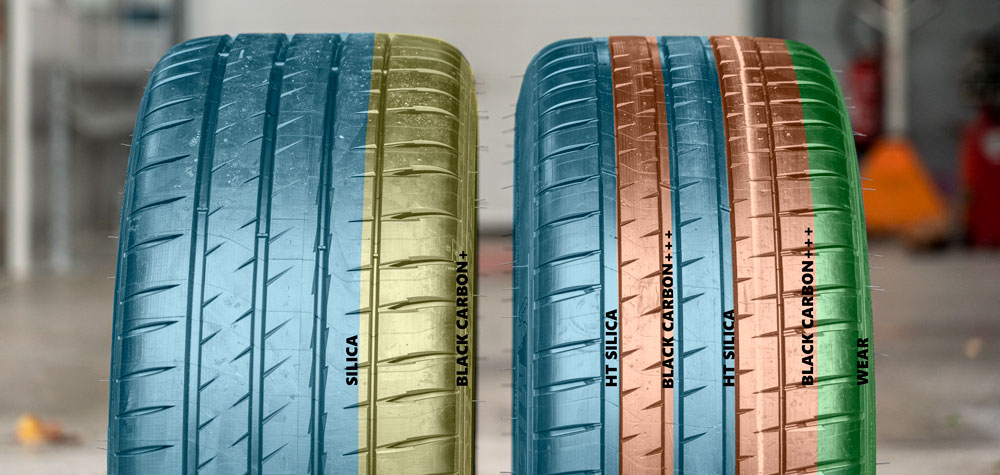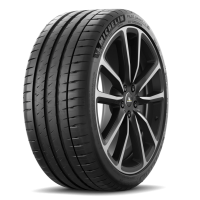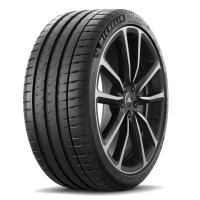Michelin and BMW spent over 2.5 years making the perfect tyre for the new G80 BMW M3 and G82 BMW M4. Here's all the work and changes that went into the project!
2 categories (2 tests)
| Test Category | Best Performer | Worst Performer | Difference |
|---|---|---|---|
| Dry (1 tests) | |||
| Dry Handling | ▲ Michelin Pilot Sport 4 S *: 70.63 s | ▼ Michelin Pilot Sport 4 S: 72.47 s | 1.8 s (2.5%) |
| Wet (1 tests) | |||
| Wet Handling | ▲ Michelin Pilot Sport 4 S: 97.63 s | ▼ Michelin Pilot Sport 4 S *: 99.3 s | 1.7 s (1.7%) |
Immediately when driving the car I felt sure the Pilot Sport 4S was no ordinary 4S, as it felt quicker to steer, stiffer, and seemed to give you more feedback, all things I've wanted from the 4S.
To find out whether this was just the car, or whether the tyre was in fact different, I dropped a message to Michelin, who invited me out to their test facility in France to find out first hand.
Before driving the two sets of tyres, I was lucky enough to interview the lead developer of the new * marked PS4S Pierre Chapu, and what I thought was going to be 5 mins chat turned into well over an hour of awesome tyre geeking! Because this is far too long to put into a single youtube video, I'm going to try my best to answer some of the common questions you've had around OE tyres, but if you really want to hear all the details, I'll get something up on tyre-reviews.com.
What are some characteristics that BMW specifically requests when homologating tyres?
Pierre said that BMW M are a very technical OEM to work with, and while they work on every aspect of the tyres performance, their key goals revolve around maximum dry grip, and precise steering with quick reaction at small steering angles… all things I really love. While this does come at the expense of some wet performance, it's very important to BMW that the balance and driveability of the car isn't lost in the wet, but it's fair to say that overall the focus is on dry performance, perhaps led by a famous certain german track.
As for the other aspects of the tyre, PS4S is already excellent in noise and rolling resistance for it's class, something I've proven in tests, so the two tyres are similar there, and while BMW M don't push for comfort, internally Michelin have a rule that the tyre can't stray too far from the original product line, which means comfort is considered.
What are the exact differences between the * marked PS4S and the regular aftermarket tyre?
This is the bit that took nearly an hour to explain, so I'll be paraphrasing a lot here, but a lot has changed!
The compound is the biggest difference, as with the OE tyre you can design the compound around the specification from BMW, and the changes are far greater than even I'd imagined with my small amount of insider knowledge.
The aftermarket tyre has a 2 compound design, with what Michelin calls black carbon + on the outer section of the tyre for cornering grip, and a high silica compound on the rest of the tread which is great for many things like wet grip, low rolling resistance and good mileage.
The BMW specification front tyre not 2, but FOUR compounds! Firstly, the black carbon compound they use is black carbon+++, with two extra plusses. This I've been told is more like the cup 2 compound than the 4S.

As this compound is more grippy, but can also have higher wear, so to balance that the OE tyre gets a high wear compound on the outer shoulder to improve wear characteristics on track. As we move into the tyre, like the OE tyre we get back to a silica based compound, but one tuned to work better at higher temperatures. As this still wouldn't meet the BMW M requirement of dry grip and steering precision, Michelin have laid another rib of black carbon +++ to give the tyre even more grip and direction change, then back to the high temperature silica.
As for the construction, well that's all different too. The OE cap ply has the same materials as the aftermarket tyre, but it's laid at a different tension which changes the contact patch on the road. The belting is actually tighter in the middle for improved steering precision, which to me is crazy levels of engineering!
The steel belting under the cap ply is also changed, it's wavy instead of flat which dips into the tread more, further improving rigidity, and the angle of the belts have also been tuned to help the tyres work perfectly with this G80 M3.
Naturally, the sidewall rigidity is also tuned. As the M3 puts a lot of demands on the front axle they increase the sidewall stiffness, and they even change the groove locations, width and starting tread depth to further tune the tyre in line with the BMW demands. While that might sound bad for wear, apparently it's not, as the narrower grooves mean there's the same amount of rubber to go through as the aftermarket tyre.
How long did this project take?
Michelin and BMW started the PS4S development program in 2017, and the first production tyre was made in mid 2020, that's more than 2.5 years of development.
There were 8 test loops with bmw in total, with more than 30 different versions of the PS4S for each axle, and the tyres were tested at Miramas (France) Nurburgring (Germany) Idiada (Spain) Ladoux (France) Ascheim (Germany), which is an impressive array of tracks.
One final note, the development engineer said that this generation of BMW xDrive system is very sensitive to overall tyre sizes, something to keep in mind when trying to decide about the OE vs aftermarket tyre.
Be sure to watch the video to see all the subjective differences in handling between the OE and Aftermarket versions of the excellent Michelin Pilot Sport 4S!
Dry
Wet
Results
1st: Michelin Pilot Sport 4 S * | |||||||||||||||||||

|
| ||||||||||||||||||
1st: Michelin Pilot Sport 4 S | |||||||||||||||||||

|
| ||||||||||||||||||








